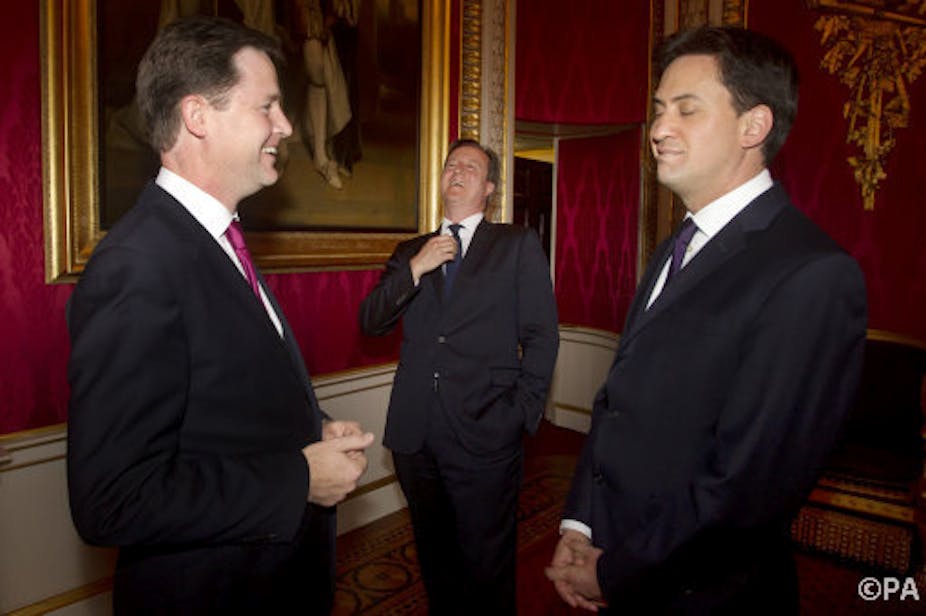If a week is a long time in politics, as Harold Wilson famously claimed, then it would seem like a hopeless task to try to predict now what might happen at the general election of May 2015. But we know that in Britain, opinion polls are indicative of future election results quite some time in advance. History also suggests that eventual election results differ from prior levels of support in the polls in predictable ways.
Building on previous work with Rob Ford, Will Jennings, Mark Pickup and Chris Wlezien, I have developed a method that allows for some predictable and unpredictable patterns of change and which can be used for producing regular forecasts of the 2015 election from up to 20 months prior. The current forecast is being published here, and is being updated weekly.
The main historical pattern that can be used to predict change in party support is that governments tend to lose support after elections but then rally in the run up to the next election, and vice versa for the main opposition party. On average, across the eight elections with incumbent Tory governments since 1945, government support dropped by 10.6% up to 20 months out, but 7.4% was recovered on average in the final 20 months. Heath was the only Tory prime minister to have fallen overall in the polls in the past 20 months. Similarly, Labour oppositions have on average lost ground gained earlier on only to regain it in the cycle’s final 20 months.
This is part of a more general tendency for initial changes in party support to be reversed. So for the Liberals, along with the two main parties, mid-term gains or losses tend to be partially reversed by the time of the election. If repeated for the 2015 election, the Liberals should recover somewhat from their current slump in the polls.
A further established pattern is that Conservatives have on average over-performed in elections relative to the polls, either 20 months prior or even from the final week. Correspondingly, Labour has underperformed relative to the polls on average. This is true of all but two of the elections since 1974, both overall and under Conservative governments. Although 2010 (along with 1983) was one of the exceptions, the tendency may not have gone away.
All these features of the historical relationship between polls and election results suggest that when the 2015 election is held, the Tories and Liberal Democrats will recover from their current position, and that Labour will fall behind.
Conservative future
Polls in early October 2013 had the Conservatives on 32% of the vote, Labour on 39%, and the Lib Dems on 10%. Back then, the method predicted a complete reversal of fortunes in a 2015 election, forecasting a Labour vote of 32% and a Conservative one of 38%. Taking into account the well-known pro-Labour bias in the electoral system as well as prediction uncertainty, the method suggested then that the Tories would have a 64% chance of being the largest party in parliament.
Despite improving news on the economy, the latest UK Polling Report average (Con 33%, Lab 38%, LD 10%) shows only a tiny move towards the Tories and away from Labour. Since this is in the direction expected, the forecast has barely moved. The share-of-the-vote forecasts have changed by no more than a percentage point for each party.
If anything, the Tory polling recovery has been slightly smaller over the past four months than the historical average suggests it could have been. The estimated probability that the Tories will be the largest party has accordingly dropped slightly to 61%. By this measure, it has been a marginally better period for Labour than the Conservatives: Labour’s success in maintaining a lead has improved its chances of winning the next election more than the apparent narrowing of the lead since October has worsened them.
But the main story is that by historical standards, the Tories are still on track to be the largest party in votes in 2015, with a good chance of also winning the most seats. It is, however, more likely that there will be a hung parliament (44%) than that we will see a Conservative majority (37%). Although the odds may be against Labour, they are not heavily so: with a 39% chance of being the largest party Labour have everything to play for.
Meanwhile, despite the absence of a long electoral history to model statistically, the method suggests UKIP could achieve an unprecedented 13% of the vote. Given they just embarrassed the Tories by beating them into third place in the Wythenshawe by-election, this will only bolster UKIP’s hopes of a historic and game-changing performance in 2015.

